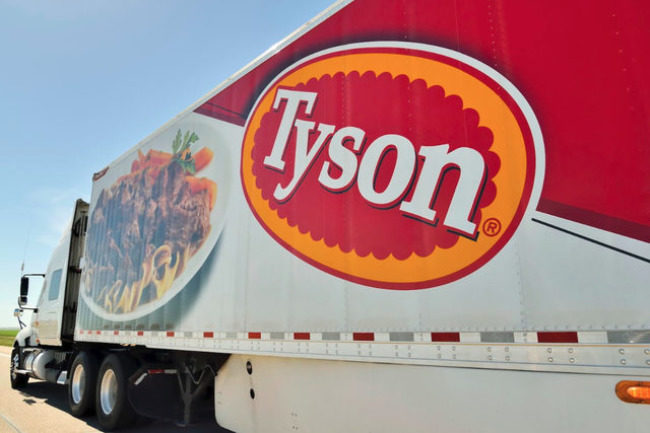SPRINGDALE, ARK. – Tyson Foods Inc., highlighted increases in earnings and sales thanks in large part to efforts to offset the impact of inflation, including raising its sales prices in the fiscal second quarter ended April 2, 2022. The company reported an overall price increase across its five business segments of 17.6%, led by the Beef business unit’s 23.8% increase.
“Our performance in the first half of the year reflects our improving operational execution and strong customer and consumer demand for our brands and products,” said Donnie King, president and chief executive officer of Tyson Foods.
“Although we continue to see inflationary pressures across the supply chain, we are working to drive costs down by continuing to increase our efficiency, productivity and bringing more capacity on line,” he said.
The company announced on June 9, that it expects overall volume to increase by 1% to 2% during the next two quarters and raised sales projections for the fiscal year to a range of $52 billion to $54 billion, exceeding previous estimates of between $49 billion and $51 billion.
The company’s adjusted net income for the quarter was $833 million, equal to $2.29 per share on the common stock, nearly 75% higher than net income of $477 million, or $1.34 per share in the same period last year. Quarterly sales increased 16% to $13.12 billion, compared to $11.3 billion during Q2 of 2021. Sales volume decreased 1.5% during the quarter. Tyson reported an adjusted operating margin for the quarter of 8.9% compared to 6.5% during the same quarter of 2021.
In the Beef segment, sales volume was incrementally higher, but hindered by continued labor shortages and supply chain challenges. Strong global beef demand and higher prices were reflected in the company’s sales of $5.03 billion for the quarter to a 24% increase over the $4.05 billion reported in the same period last year. Beef sales volume also increased by 0.6%.
“Operating income increased in the second quarter and first six months of fiscal 2022 due to strong demand as we continued to optimize revenues relative to live cattle supply and a reduction in direct incremental expenses related to COVID-19, partially offset by production inefficiencies due to the impacts associated with a challenging labor environment and continued supply chain constraints,” Tyson said.
Labor challenges also hindered Tyson’s Pork business segment in the second quarter. While the average sales price increased by almost 11%, volume decreased nearly 5%. Sales increased slightly, to $1.57 billion compared to $1.48 billion during the same period last year. Higher input costs, including labor, freight and live hogs, negatively affected operating income for the quarter, which totaled $59 million, a decrease of about 12% from last year’s $67 million. Operating income for the first half of the fiscal year was a bright spot for the segment.
“Operating income for the first six months of fiscal 2022 increased as we optimized revenues relative to live hog supply and due to a reduction in direct incremental expenses related to COVID-19, partially offset by higher inputs costs and the impacts associated with a challenging labor environment,” Tyson said.
Tyson’s Chicken segment reported a sales increase of 15% for the quarter to $4.09 billion compared to $3.55 billion the prior year with sales volume that increased by 0.6%, offset by ongoing supply chain challenges. Adjusted operating income for the quarter topped $203 million compared to $6 million in 2021. Quarterly adjusted operating margin for the segment was 5% compared to 0.2% in the same period last year. Year-to-date operating income was $320 million compared to $110 million in the first six months of fiscal 2021 with an operating margin of 4% compared to 1.6% last year.
“In the second quarter of fiscal 2022, we experienced $100 million of higher feed ingredient costs and $101 million of net derivative gains as compared to $10 million of net derivative gains in the second quarter of fiscal 2021,” Tyson said.
Lower throughput in the company’s Prepared Foods business unit was another result of labor and supply chain challenges and instability in the recovery of some foodservice companies. The acquisition of Tyson’s pet food business by General Mills for $1.2 billion in the fiscal fourth quarter of 2021 also affected volume in the segment, which declined by 5.3%. With its average price change of nearly 16%, Prepared Foods reported increased sales of $2.39 billion, an increase of nearly 11% over 2021 sales of $2.16 billion. Operating income increased in the quarter but was offset by inflationary factors that included raw materials and input costs totaling $210 million. The company is expecting adjusted operating margin for fiscal 2022 to be between 8% and 10%.
International/Other segment sales for the quarter totaled $565 million, compared to $487 million in the same period last year with volume decreasing by 5.3% and prices increasing by nearly 16%. Adjusted operating income was $263 million compared to $217 million in the same quarter of fiscal 2021, while the operating margin in the segment of 11% versus 10% last year. Tyson said it anticipates lower results from its foreign operations because of supply chain interruptions and the continued impact of COVID-19.


